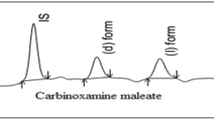Abstract
Purpose. Stereoselective and sensitive methods employing chiral stationary phase columns for HPLC determination of enantiomers of lansoprazole in the human serum were developed and pharmacokinetic behaviors of the enantiomers were evaluated in seven subjects.
Methods. Five chiral stationary phase columns: Chiralcel OD (cellulose tris(3,5-dimethyl-phenylcarbamate)), OF (cellulose tris(4-chloro-phenylcarbamate)), OG (cellulose tris(4-methylphenylcarbamate)) and OJ (cellulose tris(4-methylbenzoate)), and Chiralpak AS (amylose tris ((S)-1 -phenylethylcarbamate)) were investigated.
Results. Chiralcel OD and Chiralpak AS columns gave a good resolution of R(+)- and S(–)-enantiomers from racemic lansoprazole, but Chiralcel OF, OG, and OJ did not. The mean Cmax and the AUC values of R(+)-enantiomer were 3–5 times greater than those of S(–)-enantiomer following oral administration of 30 mg of racemic lansoprazole. The CLtot values of R(+)-enantiomer were significantly smaller than those of S(–)-enantiomer. Binding of R(+)-enantiomer to human serum proteins was significantly greater than that of S(–)-enantiomer. The mean metabolic ratio (metabolites/parent compound) in human liver microsomes of S(–)-enantiomer was significantly greater than that of R(+)-enantiomer.
Conclusions. The stereoselective pharmacokinetics of lansoprazole enantiomers is likely due to its Stereoselective protein binding and/ or metabolism.
Similar content being viewed by others
REFERENCES
J. Caldwell. The importance of stereochemistry in drug action and disposition. J. Clin. Pharmacol. 32:925–929 (1992).
T. Uematsu, M. Nakano, K. Kosuge, A. Nagai, A. Sato, and M. Nakashima. Pharmacokinetic properties of a novel gastric proton pump inhibitor, (±)-2-[(4-methoxy-6,7,8,9-tetrahydro-5H-cyclohept
G. S. Nerurkar, S. V. Dighe, and R. L. Williams. Bioequivalence of racemic drugs. J. Clin. Pharmacol. 32:935–943 (1992).
K. Miwa, M. Mitani, T. Tsukamoto, K. Yoshida, T. Kobayashi, T. Kimura, H. Simomura, and S. Tanayama. Metabolic fate of AG-1749, a new proton pump inhibitor, in rats, mice, and dogs. Jpn. Pharmacol. Ther. 18:3413–3435 (1990).
I. Aoki, M. Okumura, and T. Yashiki. High-performance liquid chromatographic determination of lansoprazole and its metabolites in human serum and urine. J. Chromatogr. 571:283–290 (1990).
Y. Imamura, K. Iwamoto, Y. Yanachi, T. Higuchi, and M. Otagiri. Postnatal development, sex-related difference and hormonal regulation of acetohexamide reductase activities in rat liver and kidney. J. Pharmacol. Exp. Ther. 264:166–171 (1993).
O. H. Lowry, A. L. Rosebrough, A. L. Farr, and R. J. Randall. Protein measurement with the Folin phenol reagent. J. Biol. Chem. 193:265–275 (1951).
M. Eichelbaum, G. Mikus, and B. Vogelgesang. Pharmacokinetics of (+), (−), and (±) verapamil after intravenous administration. Br. J. Clin. Pharmacol. 17:453–458 (1984).
B. Delhotal Landes, J. P. Petite, and B. Flouvat. Clinical pharmacokinetics of lansoprazole. Clin. Pharmacokinet. 28:458–470 (1995).
R. Mehvar, J. M. Reynolds, M. A. Robinson, and J. A. Longstreth. Enantioselective kinetics of verapamil and norverapamil in isolated perfused rat livers. Pharm. Res. 11:1815–1819 (1994).
M. Tateno, and N. Nakamura. Phase I study of lansoprazole (AG-1749) antiulcer agent—Capsule form—. Rinsho Iyaku 7:51–62 (1991).
Author information
Authors and Affiliations
Rights and permissions
About this article
Cite this article
Katsuki, H., Yagi, H., Arimori, K. et al. Determination of R(+)- and S(–)-Lansoprazole Using Chiral Stationary-Phase Liquid Chromatography and Their Enantioselective Pharmacokinetics in Humans. Pharm Res 13, 611–615 (1996). https://doi.org/10.1023/A:1016062508580
Issue Date:
DOI: https://doi.org/10.1023/A:1016062508580




